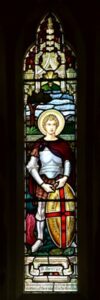Drefach Felindre is a village situated four miles south-east of Newcastle Emlyn, and lies at the confluence of three streams which open out into the Teifi Valley. The village was an important centre for the local woollen industry, and the resulting influx of workers to the local mills caused the merging of two smaller villages, Drefach and Velindre, which give the village its modern name. The National Woollen Museum is located within the village, and was opened in 1976 in the Cambrian Mill. The villagers who fell during both world wars are commemorated on the war memorial which is situated in the grounds of St. Barnabas Church, while another man who fell during the Boer War is commemorated on an individual plaque inside the Church. There is also another brass plaque and a stained glass window inside the Church which commemorates the fallen of the Great War. The photographs of the memorials have been kindly supplied by Raymond and Ken Jones.
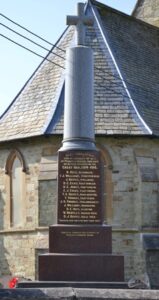
Boer War, 1899-1902
William Frederick Jones, Corporal, Rhodesia Regiment. William was born on 13 February 1870, the son of Reverend Thomas Jones, and Margaret Jones, of Drefach Velindre. He served with the British South Africa Police, and was attached to the Rhodesia Regiment, which was part of Plumer’s Column. The column was working its way to attempt to relieve the Siege of Mafeking, when William died of wounds suffered during an engagement with Boer’s at Gaberones Crocodile Pools on 13 February 1900. He is buried at Gaberones, which is today located in Botswana.
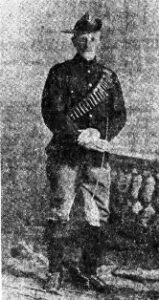
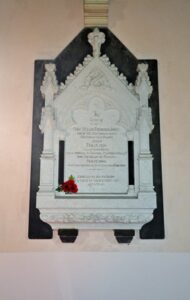
The Great War, 1914-1918
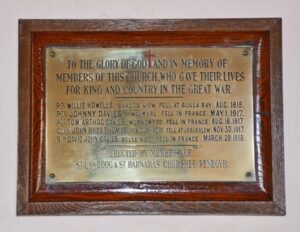
David John Davies, Private, 51866, West Yorkshire Regiment. David was the son of John and Sarah Davies, of Graigwen, Velindre. He resided at Belle Vue, Velindre with his wife Margaret Jane Davies, and their daughter Hannah prior to the war, and enlisted at Cardiff in February 1917. David originally served with the Labour Corps before transferring to the 2/8th Battalion, West Yorkshire Regiment on 28 September 1917, which was attached to 185 Brigade, 62nd (2nd West Riding) Division. The Division had been in France since January 1917, and took part in the Battle of Arras. It fought at Cambrai later that year, before settling down for the winter in the Arras sector. On 21 March 1918 the German Spring offensive hit the area, and the Division was one of several to suffer terrible casualties over the coming days. David was killed on 29 March 1918, aged 33. He has no known grave, and is commemorated on the Arras Memorial, France.
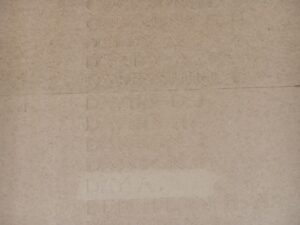
John Davies, Private, 20630, Welsh Regiment. John was the son of David and Margaret Davies, of Pwllmarl, Velindre. He had married prior to the war, and resided with his wife Hannah Davies, at Brynheulog, Beulah. John enlisted at Ammanford during an early recruiting drive into the 15th Battalion (Carmarthen Pals), Welsh regiment, which formed and trained at Rhyl, before moving to Wiltshire, with 114 Brigade, 38th (Welsh) Division. The Division moved to France in December 1915, and John saw action the following year in the famous assault on Mametz Wood. After the successful capture of the wood, the decimated 38th Division moved to the Boesinghe Sector, north of Ypres. After several months spent consolidating the line at Boesinghe, on the night 29/30 April 1917, the 15th Welsh carried out a successful large scale trench raid on the German lines opposite. John was wounded during the raid, and died on 1 May 1917. He was 22 years old, and is buried at Mendinghem Military Cemetery, Belgium.

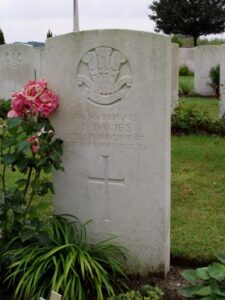
Thomas Arthog Davies, Private, 33348, South Wales Borderers. Thomas was the son of David and Hannah Davies, of Wern Newydd, Cwmpengraig, Henllan. He was an Undergraduate of St. David’s College, Lampeter, and was preparing for the Ministry of Church of England when war disturbed his studies, and enlisted at Aberystwyth into the 2nd Battalion, South Wales Borderers. In April 1917 Thomas went to France to join the battalion, which was attached to 87 Brigade, 29th Division at Arras. The Division soon moved to the Ypres sector, and took part in the Battle of Langemarck. Thomas was killed here on 16 August 1917. He was 26 years old, and is commemorated on the Tyne Cot Memorial, Belgium.
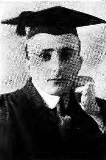
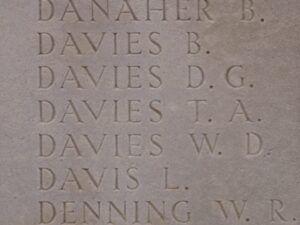
David Emlyn Esau, Driver, 137098, Royal Field Artillery. David was the son of William John and Catherine Esau, of Pantybwlch, Newcastle Emlyn. He enlisted at Preston into the Royal Field Artillery, and was posted to the 79th Small Arms Ammunition Column, which was attached to the 79th Brigade, 26th Division. Embarkation for France began in September 1915, and the concentration of units at Guignemicourt, west of Amiens, was completed before the end of the month. However in November 1915 the Division moved to Salonika, where it then remained. On 26 December 1915 units began to move from Lembet to Happy Valley Camp, and all units were in place there by the 8th February. The Division then took part in the Battle of Horseshoe Hill, between the 10th and the 18th August 1916, the Battle of Doiran between 24 April and 9 May 1917. David sadly died of dysentery on 5 October 1917. He was just 22 years old, and is buried at Mikra British Cemetery, Kalamaria.
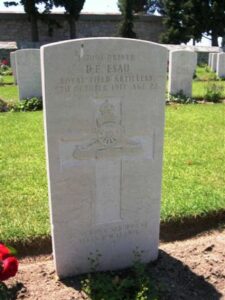
Edward James Evans, Private, 88425, Machine Gun Corps. Edward was the son of Henry and Elizabeth Evans, of Pantywenol, Velindre. He enlisted into the 4th Welsh at Carmarthen in November 1916, and in May 1917 moved to France, where he joined the 43rd Company, Machine Gun Corps, which was attached to the 14th (Light) Division. The Division was still at Arras, but soon moved to Ypres, where it relieved the 38th (Welsh) Division in August 1917 at Langemarck. Edward was killed at the Battle of Langemarck on 22 August 1917. He was 22 years old, and is commemorated on the Tyne Cot Memorial, Belgium.
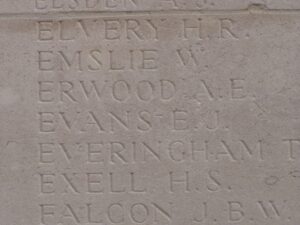
William Howells, Private, 2536, Welsh Regiment. William was the son of Samuel Howells, of Bargoed View, Velindre. He enlisted at Carmarthen into the 1/4th Battalion, Welsh Regiment, which was the local Territorial unit. The battalion was attached to 159 Brigade, 53rd (Welsh) Division, and sailed from Devonport in July 1915 arriving at Mudros on 5 August 1915. From here they moved to Gallipoli, landing on 9 August. Here the Division was immediately thrown into action, and spent the next few days in isolated pockets, fighting against a Turkish counter-attack during the Battle of Sari Bair. William was killed here on 10 August 1915. He was 21 years old, and is commemorated on the Helles Memorial, Gallipoli.
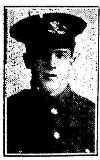
David Emlyn Jones, Private, 202757, Welsh Regiment. David was the son of James and Catherine Jones, of Llain, Cilrhedin, and the husband of Rebecca Jones, of Pantycelyn, Velindre. He enlisted at Carmarthen into the 4th Welsh, and was posted to France to join the 9th Battalion, Welsh Regiment, which was attached to 58 Brigade, 19th (Western) Division. David probably joined the Division after its efforts on the Somme in 1916, and Messines Ridge in 1917, and joined them at Ypres during October 1917. David had only joined his platoon a few days before being killed in action at Cambrai on 12 December 1917, while at sentry duty. He was 27 years old. His officer, Lieutenant Rankin, wrote home to inform Rebecca that David had been buried about 500 yards from where he fell, in a small wood, and his grave was marked by a cross. Sadly his grave was lost during further fighting in the area, and David is now commemorated on the Thiepval Memorial, France.
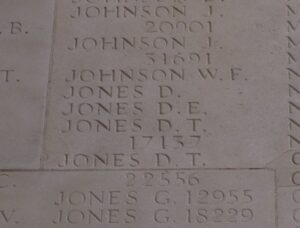
Benjamin Rees, Private, 13127, Welsh Regiment. Benjamin was the son of David and Hannah Rees, of Rhydhalen, Newcastle Emlyn. He worked as a Colliery Hewer prior to the war, residing at 18, Railway Terrace, Tumble, and he enlisted at Tumble into the Welsh Regiment. Benjamin landed in France on 3 December 1914, joining the 2nd Battalion, Welsh Regiment. The Battalion was attached to 3 Brigade, 1st Division, which was one of the first to arrive in France, fighting at the Battle of Mons, and taking part in the retreat to the Marne, where the Germans were stopped. They then fought at the Aisne, and at Chivy, before being moved north to Ypres. Here they fought at the First Battle of Ypres, where they again stopped the German Offensive, before wintering in Flanders. Benjamin was killed in action in Flanders, during the First Action of Givenchy, on 25 January 1915 aged 31. He has no known grave, and so is remembered on the Le Touret Memorial, Richebourg L’Avoue.
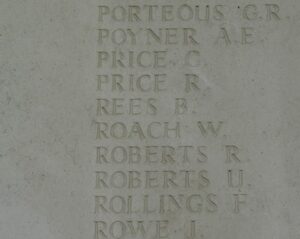
Daniel Evan Rees, Private, 28724, Somerset Light Infantry. Daniel was the son of Thomas and Sarah Rees, of Pleasant View, Velindre, and the Husband of Martha Rees, of Lincoln House, Velindre. He enlisted at Newport, Monmouthshire into the Monmouthshire regiment, but was later posted to the 1st Battalion, Somerset Light Infantry. The battalion had been in France since the outbreak of war, attached to 11 Brigade, 4th Division. The Division had taken part in all of the major actions of the war, and moved to the Arras sector after taking a part in Third Ypres. Daniel was wounded during the time of the Battle of Cambrai, and died on 4 December 1917, aged 29. He was buried at Duisans British Cemetery, Etrun, France.
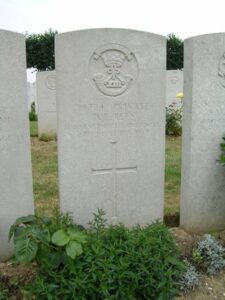
John Rhys Thomas, Private, 355874, Royal Welsh Fusiliers. John was the son of John and Hannah Thomas, of Penlonrhadis, Velindre. He enlisted at Penarth on 8 September 1914 into the South Staffordshire Regiment, but was discharged as medically unfit on 9 June 1915. Undeterred, he re-enlisted into the Welsh Horse Yeomanry, and joined the regiment in Egypt on 14 February 1916. Here the Welsh Horse merged with the Montgomery Yeomanry to form the 25th Battalion, Royal Welsh Fusiliers, which was attached to 231 Brigade, 74th (Yeomanry) Division. In March 1917 the Division began its part of the advance into Palestine, and by November had helped capture Jerusalem. John was killed near Jerusalem on 30 November 1917. He was 23 years old, and is buried at Jerusalem War Cemetery, Israel.
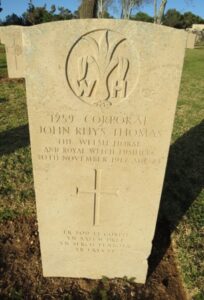
Thomas Thomas, Private, 125589, Machine Gun Corps. Thomas was the son of John and Ann Thomas, of Pantycoed, Cilrhedyn. He enlisted at Carmarthen into the Welsh Regiment, and was posted to France, joining the 36th Battalion, Machine Gun Corps, which was attached to the 36th (Ulster) Division. The division had seen heavy fighting on the Somme in 1916, and at Ypres in 1917. It then fought at Cambrai later that year, before wintering in the Somme sector. When the Germans launched their offensive on the Somme on 21 March 1918 the division was again caught up in heavy fighting, and was moved to Ypres to rest. It saw further heavy fighting when the Germans switched their attack to the Lys Valley the following month. Thomas was mortally wounded here, and died on 29 May 1918, aged 24. He is buried at Solferino Farm Cemetery, Belgium.
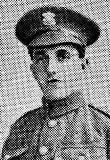
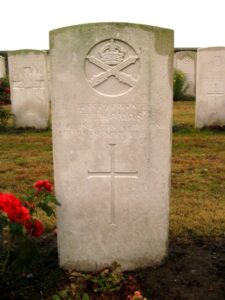
John Lewis Williams, Private, 34847, Royal Welsh Fusiliers. John was the son of James and Elizabeth Williams, of Manoravon, Drefach, Henllan. He served with the 10th Battalion, Royal Welsh Fusiliers, which moved to France in September 1915 and became attached to 76 Brigade, 3rd Division. John probably joined the battalion at some time in 1916 and moved with the battalion to the Somme. He saw his first fighting when the battalion moved up to Montauban Alley on 14 July and during the coming days the battalion suffered heavy casualties. The battalion went back into reserve during the last week of July and on 14 August began to move back towards the new front line, reaching Casement and Dublin trenches on 16 August 1916. John was one of three men killed when the battalion moved forwards to Chimpanzee Trench early that morning. He was 29 years old, and is commemorated on the Thiepval Memorial, France.
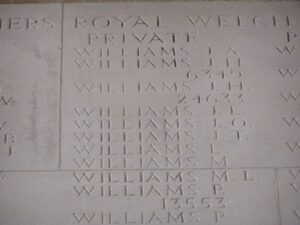
Thomas James Williams, Private, 11050, Welsh Regiment. Thomas was born on 15 November 1894, the son of George and Hannah Williams, of 2, Gilwen Terrace, Velindre. He enlisted in December 1913 and joined the 2nd Battalion, Welsh Regiment. At the outbreak of war, the Battalion was at Pembroke Dock, and moved to France as part of 3 Brigade, 1st Division. The 2nd Welsh took part in the retreat from Mons, and played an important role at First Ypres, where the German offensive was stopped. Thomas was taken ill soon after, returning home on leave before moving back to France where he joined the 1st Welsh. Tom was killed at Second Ypres, during a bayonet charge at Zillebeke on 25 May 1915, aged 21. He is commemorated on the Ypres (Menin Gate) Memorial, Belgium.
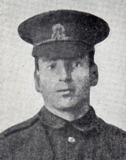
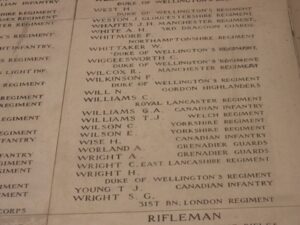
World War Two, 1939-1945
Elvin Davies, Private, 4200974, South Staffordshire Regiment. Elvin was the son of John and Ann Davies, of Lonfawr, Velindre. He served with the 2/6th Battalion, South Staffordshire regiment, which was attached to 177 Brigade, 59th (Staffordshire) Division. The Division had landed in Normandy in early July, and moved to positions around Caen, where they were to take part in Operation Charnwood, the capture of Caen. Elvin was killed in action during the initial attack on 8 July 1944. He was 24 years old and is buried at Cambes-en-Plaine War Cemetery, France.
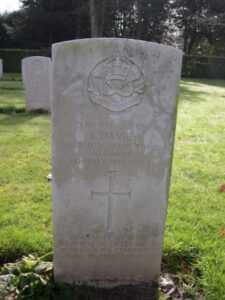
David John Howells, Trooper, 4195878, Royal Armoured Corps. David resided at Ffynonwen, Velindre. He served with the 49th (West Riding) Regiment, which was attached to the Reconnaissance Corps, Royal Armoured Corps. The unit had fought in Norway in 1940, and was stationed for a period in Iceland before returning to England in 1942. Just after D-Day, in June 1944, it moved to Normandy as part of XXX Corps, and took part in the famous advance through France and Belgium into Holland during Operation Market Garden. David was killed in Belgium on 25 September 1944, aged 25, and is buried in Geel War Cemetery, Belgium.
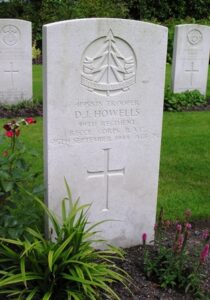
David John Jones, Gunner, 919650, Royal Artillery. David was the son of Daniel and Elizabeth Jones, of Waunlwyd, Velindre, and the husband of Annie Mary Jones, of Wimbledon, Surrey. He served with the 146 (The Pembrokeshire Yeomanry) Field Regiment, Royal Artillery. The regiment embarked for North Africa and landed in Suez in September 1942, joining the Eighth Army in time for the battle of El Alamein as part of the 7th Armoured Division Artillery (the Desert Rats). David was killed during Operation Vulcan on 26 April 1943, aged 31, and is buried in Enfidaville War Cemetery, Tunisia.
John Thomas Lewis, Flying officer (Navigator), 163556, Royal Air Force Volunteer Reserve. John was born on 1 March 1922, the son of Eiffel Sidney Lewis and Amelia Lewis (nee Davies), of Garth, Drefach. He was educated at Llandyssul School prior to becoming a Policeman at Portsmouth prior to the war. John then enlisted into the Royal Air Force Volunteer Reserve where he trained as a Navigator. He was killed alongside all his crew when their Halifax bomber crashed during landing at RAF Rutterworth on 16 November 1944. John was 22 years old, and is buried at Drefach Baptist Cemetery.
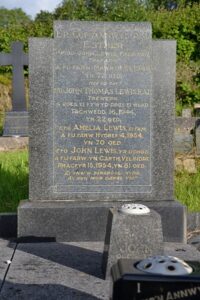
Edward George Vare, Serjeant, 7880459, Royal Armoured Corps. Edward was the son of Percy and Elizabeth Mary Vare of Penally. He had married prior to the war, and lived with his wife Maud Vare, at Waungilwen, Cardiganshire. Edward served with the 12th Royal Tank Regiment, Royal Armoured Corps, which fought in North Africa, before taking part in the invasions of Sicily and Italy. Edward was killed in action in Italy on 6 May 1943. He was 32 years old, and is buried at Massicault War Cemetery, Italy.
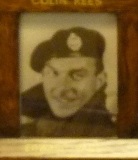
Robert Frederick Wood, Marine, CH/X 3476, Royal Marines. Robert was the son of Robert Lewis Wood and Eva Wood, and the husband of Hannah Mary Wood, of Velindre. He served with No. 40 Royal Marine Commando, which had been originally formed in February 1940, designated Royal Marine Commando, and took part in the Dieppe Raid on 19 August 1942. On its return from Dieppe, the Commando was re-designated No. 40 Royal Marine Commando, and was sent to the Mediterranean, moving to Sicily in July 1943. In September it saw action at Pizzio, and in October at Termoli. 1944 saw the Commando at Anzio, before moving to Yugoslavia and Albania. Robert was killed on the Dalmation Islands on 3 June 1944, aged 22. He is buried at Belgrade War Cemetery, Serbia and Montenegro.
